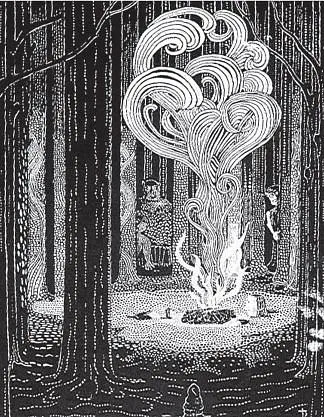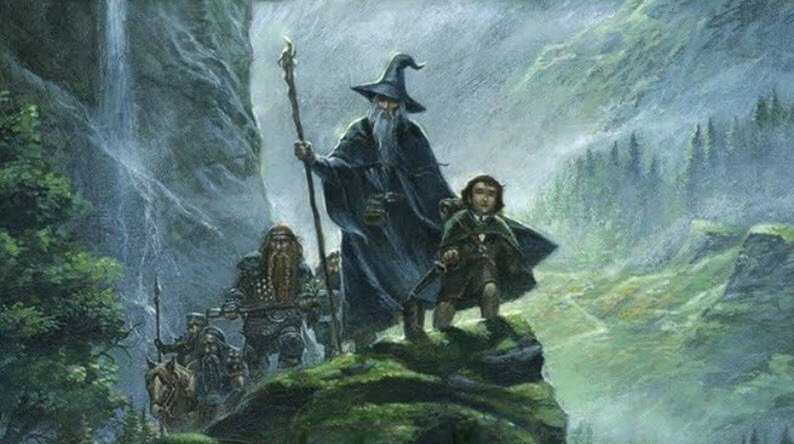My journey to Middle-earth began in the most unexpected of places: my eighth-grade English class. Our teacher, knowing full well the imaginations she was about to set alight, read aloud the chapter “Riddles in the Dark” from The Hobbit. I was instantly captivated. That summer, at the ripe old age of thirteen, I embarked on what would become a lifelong adventure, devouring The Hobbit and The Lord of the Rings in a haze of summer sun and second breakfast. Thirty years later, the magic of that first journey through Tolkien’s world still hasn’t faded.
It’s a testament to the enduring power of J.R.R. Tolkien’s classic tale that The Hobbit, often categorized as children’s literature, continues to resonate so deeply with readers of all ages. Perhaps it’s the timeless themes of courage and friendship, the allure of a richly imagined world, or the simple yet profound message that even the most ordinary among us can rise to meet extraordinary challenges. Whatever the reason, The Hobbit remains a captivating journey “there and back again” to a place where wonder and imagination reign supreme.
“Thirty years later, the magic of that first journey through Tolkien’s world still hasn’t faded.”


Stepping into a Wider World
We first meet Bilbo Baggins, our reluctant hero, living a life of comfortable routine in his beloved hobbit-hole. He’s perfectly content with his well-stocked pantry, his pipeweed, and the peaceful rhythm of life in the Shire, a tranquil land inhabited by hobbits— a folk fond of good food, good company, and a distinct aversion to adventure. Bilbo, it seems, embodies these traits to a fault.
But fate, as it so often does, has other plans. Enter Gandalf the Grey, a wizard with a knack for disrupting hobbit routines and a twinkle in his eye that hints at mischief and grand adventure. Gandalf arrives at Bilbo’s doorstep with a company of boisterous dwarves, a quest to reclaim lost treasure, and a proposition that will turn Bilbo’s ordered world upside down.
What follows is a journey that will take Bilbo (and the reader) far beyond the familiar borders of the Shire. Tolkien’s masterful world-building transports us to a realm of ancient forests, misty mountains, and treacherous caves. We encounter fantastical creatures—elves, goblins, trolls, and a dragon of epic proportions—each beautifully rendered and woven seamlessly into the fabric of Middle-earth.


Unexpected Heroism
Bilbo, initially thrust into the adventure against his will, embodies the concept of the unlikely hero. He’s not a warrior or a prince; he’s a hobbit who values his creature comforts and would much rather be at home with a cup of tea and a good book. Yet, as the quest unfolds, Bilbo discovers a wellspring of courage and resourcefulness within himself that he never knew he possessed.
His heroism is often quiet and understated, found not in grand displays of strength but in small acts of kindness, moments of quick thinking, and a steadfast refusal to give in to fear or despair. He confronts giant spiders, outwits greedy goblins, and even faces down the fearsome dragon, Smaug, all the while remaining true to his gentle nature.
Importantly, Bilbo’s actions have consequences that ripple far beyond his own personal journey. He inadvertently sets in motion events that will shape the fate of Middle-earth for generations to come. It’s a powerful reminder that even the smallest among us can have an impact on the wider world, often in ways we never could have imagined.
“It’s a powerful reminder that even the smallest among us can have an impact on the wider world, often in ways we never could have imagined.”


Beyond the Adventure
While The Hobbit is undoubtedly an exciting adventure story, its enduring appeal lies in its exploration of universal themes that resonate long after the final page is turned. Tolkien reminds us of the importance of loyalty, the transformative power of friendship, and the dangers of greed and prejudice.
The bonds forged between Bilbo and the dwarves highlight the strength that comes from facing adversity together. Their journey is a testament to the idea that true friendship can blossom in the most unexpected places and withstand even the most formidable challenges.
Moreover, Tolkien subtly weaves in commentary on the dangers of judging others based on appearances or preconceived notions. The dwarves, initially dismissive of Bilbo’s abilities due to his hobbit nature, come to rely on his courage and resourcefulness. Their evolving relationship challenges us to look beyond superficial differences and recognize the value that lies within each individual.


A Legacy of Wonder
The impact of The Hobbit on fantasy literature and popular culture is undeniable. Tolkien’s richly imagined world, captivating characters, and timeless themes have inspired countless writers, artists, filmmakers, and gamers. The book’s enduring legacy is a testament to the power of imagination and the enduring human need for stories that transport us to worlds beyond our own.


A Journey Worth Taking
Whether you’re a seasoned adventurer in the realms of fantasy or a newcomer eager to embark on your first quest, The Hobbit offers a journey worth taking. It’s a story that will stay with you long after you’ve turned the final page, reminding you of the importance of courage, kindness, and the power of a good second breakfast.
And for those who find themselves utterly charmed by Bilbo’s adventures, the story doesn’t end there. The Hobbit serves as a prelude to The Lord of the Rings, an epic saga that plunges us even deeper into the heart of Middle-earth. But that, as they say, is a story for another time.
